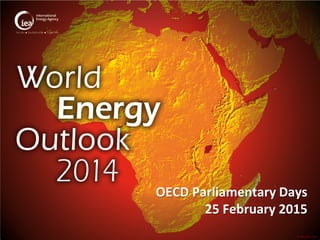
World Energy Outlook - Parliamentary Days 2015
- 1. © OECD/IEA 2014 OECD Parliamentary Days 25 February 2015
- 2. © OECD/IEA 2014 Changing dynamics of global demand Energy demand by region As China slows, then India, Southeast Asia, the Middle East and parts of Africa & Latin America take over as the engines of global energy demand growth. 2 000 4 000 6 000 8 000 10 000 1990 2000 2010 2020 2030 2040 Mtoe OECD Rest of world China China Rest of world OECD
- 3. © OECD/IEA 2014 Rich in resources In the last 5 years, almost 30% of global oil & discoveries were in sub-Saharan Africa; Hydro Wind Oil Oil Oil OilGas Gas Oil Coal Gas Fossil fuels Solar the region has vast untapped renewables potential, notably hydropower & solar
- 4. © OECD/IEA 2014 Power sector investment, regional cooperation & improved management of resources & revenues are three pillars of a brighter sub-Saharan energy future Less than 50% More than 50% Share of population with access to electricity: Rich in resources, but poor in supply 2012 2020 2025 2030 2035 2040 200 400 600 800 Million Population without electricity
- 5. © OECD/IEA 2014 2013 2020 2030 20402015 Instability in the Middle East a major risk to oil markets Oil production growth The short-term picture of a well-supplied market should not obscure future risks as demand rises to 104 mb/d & reliance grows on Iraq & the rest of the Middle East +5 +10 +15 -5 2013 2020 2030 20402015 Net decline in output from other producers Increase to 2040: 14 mb/d mb/d Increase to 2040: 14 mb/d Middle East Brazil Canada United States & reliance grows on Iraq & the rest of the Middle East in United States, Canada, Brazil & the Middle East
- 6. © OECD/IEA 2014 Looking ahead on the oil price Against a backdrop of weaker demand, buoyant supply in North America has brought prices down – but can it keep them down? Lower prices are starting to curtail upstream spending plans, with implications for future supply Over time, squeezed cash flow would constrain the capacity of North America & Brazil to act as engines of global supply growth An oil price at current levels could provide some breathing space to major oil importers, boosting demand & GDP The fall in export revenue a painful blow to some major OPEC producers & Russia, affecting economy & geopolitics
- 7. © OECD/IEA 2014 The oil price is hitting 2015 upstream spending plans Global upstream oil and gas investment Announced spending cuts for 2015 are highest (at 20-40%) in North America & Brazil; for US tight oil, a decision to stop drilling feeds through quickly into production levels 250 500 750 Billiondollars 2012 2013 2014 2015 (est.) 17%
- 8. © OECD/IEA 2014 Gas on the way to become first fuel, with role of LNG on the rise Main sources of regional LNG supply Share of LNG rises in global gas trade, pushed by a near-tripling in liquefaction sites: LNG brings more integrated & secure gas markets, but only limited relief on prices Middle East Australia US & Canada East Africa Russia North Africa West Africa Other Middle East Southeast Asia West Africa Australia North Africa Other 100 200 300 400 500 600bcm 2012 2040
- 9. © OECD/IEA 2014 Retirements add to the investment challenge in the power sector Power capacity by source, 2013-2040 Despite limited demand growth, OECD countries account for one-third of capacity additions – to compensate for retirements & to decarbonise 2013 Retirements Additions 2040 2 000 4 000 6 000 8 000 10 000 12 000GW Renewables Nuclear Oil Gas Coal
- 10. © OECD/IEA 2014 Nuclear capacity grows by 60%, but no nuclear renaissance in sight Net capacity change in key regions, 2013-2040 By 2040, an expanded nuclear fleet has saved almost 4 years of current CO2 emissions & for some countries has improved energy security & balances of energy trade -20 0 20 40 60 80 100 120 140 European Union Japan United States Russia India China GW
- 11. © OECD/IEA 2014 50 100 150 200 1990 2000 2010 2020 2030 2040 GW 2013 Nuclear power: public concerns must be heard and addressed Retirements of nuclear power capacity 1990-2040 Key public concerns include plant operation, decommissioning & waste management; Spent nuclear fuel European Union United States Japan Others 38% of today’s capacity to retire by 2040 1971-2012 350 thousand tonnes 1971-2040 705 thousand tonnes 1971-2040: 705 thousand tonnes United States European Union JapanChina Canada Russia Korea India Other By 2040, almost 200 reactors are retired & the amount of spent fuel doubles& the amount of spent fuel doubles
- 12. © OECD/IEA 2014 The entire global CO2 budget to 2100 is used up by 2040 – Paris must send a strong signal for increasing low-carbon investment four times beyond current levels The 2 °C goal – last chance in Paris? World CO2 budget for 2 °C ~2300 Gt 25% 50% 75% 100% Share of budget used in Central Scenario 1900-2012 2012-2040 Average annual low-carbon investment, 2014-2040 Central Scenario For 2°C target 2013 CCS Nuclear Renewables Efficiency The entire global CO2 budget to 2100 is used up by 2040 0.5 1.0 1.5 2.0 Trilliondollars(2013)
- 13. © OECD/IEA 2014 Navigating a stormy energy future Geopolitical & market uncertainties are set to propel energy security high up the global energy agenda Volatility in the Middle East raises short-term doubts on investment & spells trouble for future oil supply Nuclear power can play a role in energy security & carbon abatement – but financing & public concerns are key issues Without clear direction from Paris in 2015, the world is set for warming well beyond the 2 °C goal Far-sighted government policies are essential to steer the global energy system on to a safer course
- 14. © OECD/IEA 2014 www.worldenergyoutlook.org email: weo@iea.org
